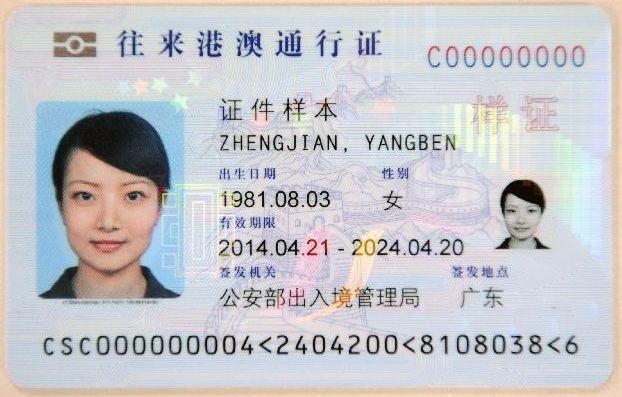Eligibility requirements Chinese citizens | Type of document Travel document Cost ¥100 | |
 | ||
Expiration 5 years (booklet version and biometric version for children)10 years (biometric version for adult) | ||
The Exit-Entry Permit for Travelling to and from Hong Kong and Macau (Chinese: 往来港澳通行证), colloquially known as a Two-way Permit (Chinese: 双程证) or EEP (Exit-Entry Permit) is issued to Chinese nationals with residency in Mainland China as a travel document for the sole purpose to travel the Chinese Special Administrative Regions of Hong Kong and Macau. The Bureau of Exit and Entry Administration of the Chinese Ministry of Public Security is responsible for the issuing of Two-way Permits and exit endorsements.
Contents
Due to the "One country, two systems" policy, Hong Kong, Macau and Mainland Chinese residents who are Chinese citizens cannot use their Chinese, Hong Kong, or Macau passports to enter their respective territories, even though those passports are considered legal valid travel document. The Two-way Permit is the sole travel document for personal visit, family reunion, business, and other non-government purposes to and from the two Chinese Special Administrative Regions. Exceptions are Mainland residents who are transiting to or from a third country or region, as they can use their Chinese passports when entering Hong Kong or Macau for a stay of seven days.
Physical appearance
The new version of the permit is changed to a credit-card sized document, which also contains a biometric chip, and was first introduced in Guangdong on May 20, 2014, and later issued nationally on September 15, 2014. The design is similar to the Taiwan Compatriot Permit but the card's color scheme is in light blue. The personal data are directly imprinted on the front of the card while the back of the card contains heat-sensitive ink which are used to print entry endorsements.
Previous version of the permit is a passport-like booklet format, with a blue cover and the National Emblem of the People's Republic of China in gold. The words "中华人民共和国" (People's Republic of China) and "往来港澳通行证" (Exit-Entry Permit for Travelling to and from Hong Kong and Macau) are displayed in simplified Chinese characters. The booklet-type permit has 32 pages for entry endorsements, and the biodata page, with the machine-readable code, is located in the back cover, unlike Chinese passports. All personal data are printed solely in Simplified Chinese, with only the name of the holder transcribed into Pinyin.
Issuing process
Two-way Permits are issued, just like the Chinese passport, by local Exit and Entry Administrations (EEA) of local Public Security Bureaus (PSB) of their places of residence. Mainland residents must apply for a new permit in person, while exit endorsements can be obtained either through the automatic endorsement machine located in EEA offices or by mail for persons residing in Guangdong. Exit endorsements are not issued to a permit with a remaining validity of less than three months.
Types of exit endorsement for Two-way Permit
In general, a Mainland resident who is in possession of a valid EEP bearing a valid exit endorsement (Chinese: 往来港澳签注) may exit Mainland China and land in Hong Kong, with a limit of stay in accordance with the exit endorsement, provided that normal immigration requirements are met. The number of journeys permitted to Hong Kong are stated in the exit endorsement, i.e. single-journey, double-journey or multiple-journey; and every endorsement has a "valid for/until" date, which refers to the expiry of endorsement and shall not be confused with the length of stay. There are six types of exit endorsements issued by Ministry of Public Security:
In addition, 奥运A was a specially-designated endorsement for 90 days multiple exits and entries during the 2008 Summer Olympics in Beijing.
Women who are more than 28 weeks pregnant and suspected to be entering Hong Kong to give birth must show a booking confirmation at a Hong Kong hospital.
Exit endorsements issued to the booklet-type permit are affixed on one of the endorsement pages, similar to visas, while card-type permits have the information stored in the chip. The heat-sensitive ink in the back of the card ensures that the exit endorsements are visible to human eyes and can be re-printed by the special printer after the endorsement is used or invalid.
